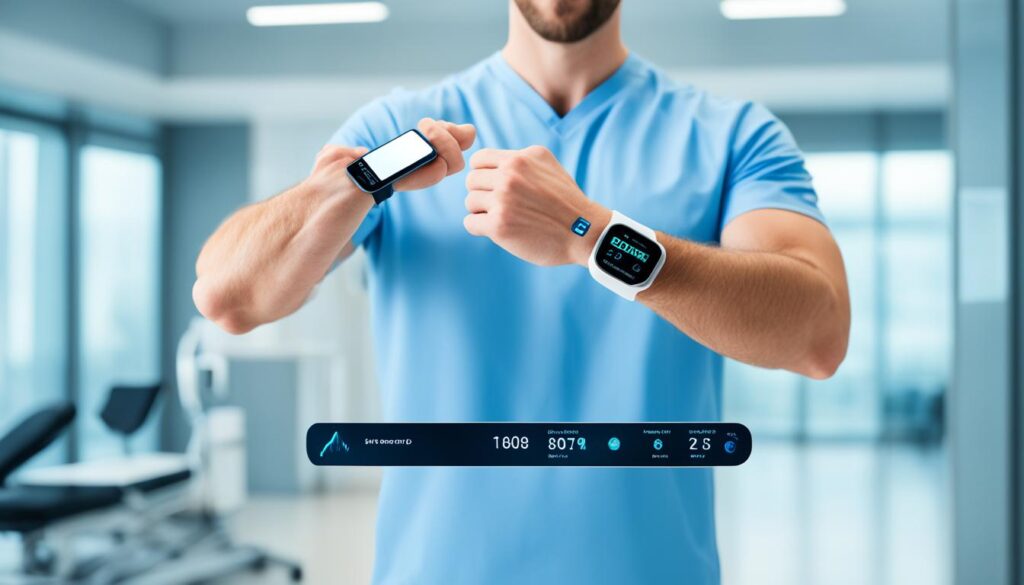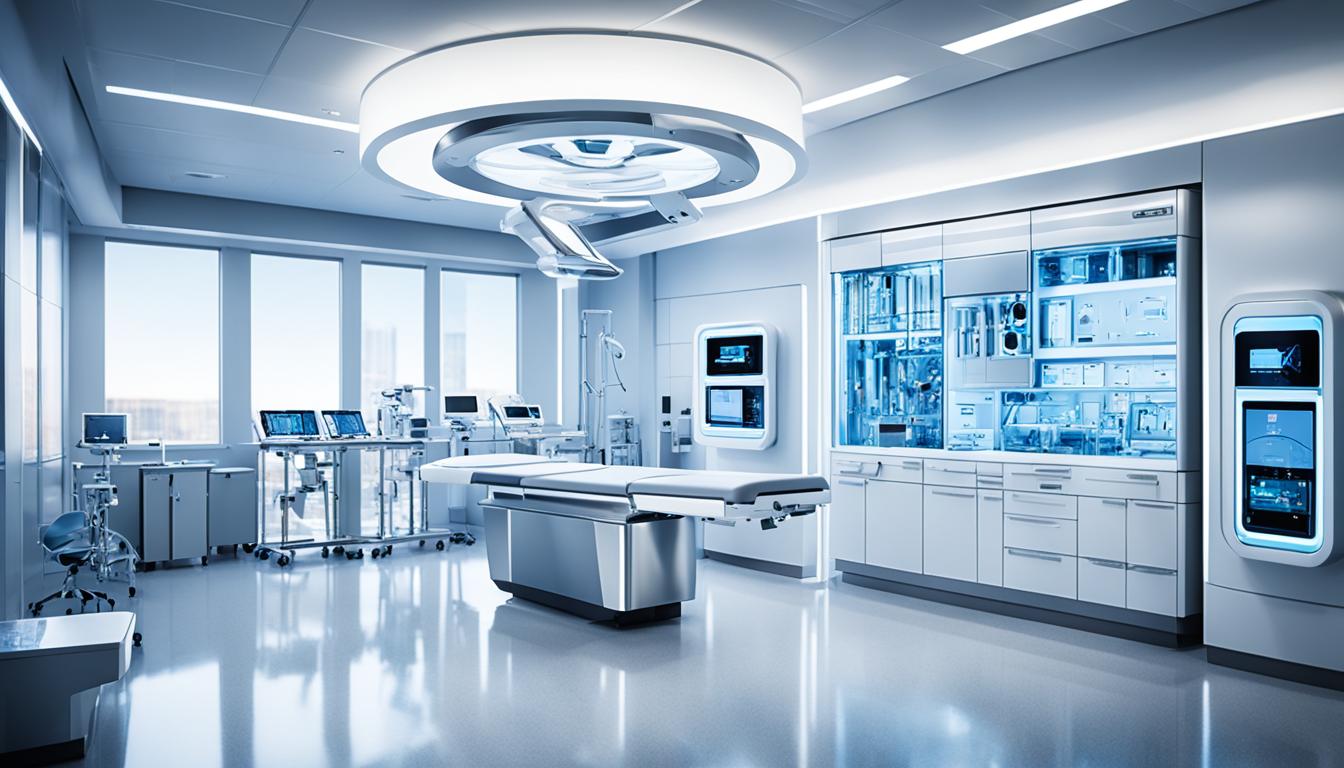“As an Amazon Associate I earn from qualifying purchases.” .
Have you ever thought about what drives healthcare innovation today? If you are intrigued by how advanced medical equipment changes patient care, you’re not the only one. Innovative Medical Solutions (IMS) leads in providing advanced medical tech solutions. They aim to change medical practices in the Arab world, the Middle East, and Western Asia.
IMS is dedicated to healthcare innovation. They have deep knowledge of local healthcare systems and international medical standards. This makes them a dependable partner in their region. They set new medical standards and offer top-notch equipment. IMS ensures healthcare pros have what they need for modern medicine.
AdvaMed works with leaders in the 118th Congress. They address important medtech issues together. This advocacy pushes technologies like X-Ray and MRI to set new standards. Companies like Stryker, as AdvaMed members, get access to valuable resources through this partnership.
Key Takeaways
- Innovative Medical Solutions (IMS) is a key provider of advanced medical tech solutions.
- IMS focuses on healthcare innovation across the Arab world, the Middle East, and Western Asia.
- AdvaMed collaborates with Congress leaders to set industry standards in medical imaging technology.
- AdvaMedDx champions timely regulatory approval for diagnostic testing.
- AdvaMed Digital Health Tech emphasizes the role of digital medical technologies in improving patient care.
The Future of Medical Devices
The future of medical devices is bright thanks to advances in technology. AdvaMed works with leaders and experts to support innovation in this field. They make sure new medical solutions reach people everywhere.
Cutting-edge Innovations
AdvaMed is leading a new wave of medical device innovation, with AI and machine learning at the forefront. These advances allow for personalized healthcare, making treatments specific to each person. Implantable devices that monitor and treat conditions in real-time change ongoing care.
Smart devices provide immediate data, improving how well patients do. These steps forward change how health issues are handled and treated. They show why it’s vital to keep innovating in medical device technology.
Enhanced Patient Monitoring
Technology in patient monitoring is getting better, giving health workers tools they need. Implantable and connected devices deliver crucial data quickly. This helps improve patient results a lot.
The FDA and EMA set high standards for device safety and effectiveness. It’s tough, but the industry keeps up and meets the challenge. Companies also deal with various global rules and protecting patient data. AdvaMed plays a key role in overcoming these obstacles, ensuring devices are safe and work well.
For more about the future of medical devices, check out this detailed resource.
The Role of Digital Health in Modern Medicine
Today, digital health is key in improving patient care in fast-changing healthcare. The pandemic made digital tools like machine learning and mobile apps more common. These technologies help by giving new ways to do things like telehealth and health apps.
Telemedicine for Remote Healthcare
Telemedicine is now vital for health care from afar. It lets doctors reach people in far places, offering quality care to everyone. Now, doctors can check patients remotely with the help of software and technology.
The Impact of mHealth Applications
mHealth apps are changing how we get health care. They offer care that fits the patient and lets them keep track of their health. With these apps, you can watch your health, handle chronic diseases, and get feedback from doctors instantly.
Advancements in Health Informatics
Health informatics is crucial for better patient care by handling health data well. Using chatbots and AI helps diagnose easier in primary care, making health care quicker and easier. Genomics testing lets doctors tailor treatments to our genetic details. Machine learning can spot things doctors might miss, improving how we understand test results like ECGs.
Digital health, including telehealth and health IT, is essential for better talks between doctors and patients. It makes care more focused on the patient. As we go on, these technologies will keep changing health care and making patient outcomes better.
Biomedical Engineering Breakthroughs
Biomedical engineering is changing healthcare in big ways. It’s making new medical advancements possible. This field improves diagnostics, treatments, and prosthetics, which raises the level of patient care.

The evolution of X-ray machines has made healthcare better by providing key diagnostic data.
EKG machines, too, have changed how we diagnose heart conditions. These advances show how far medical technology has come.
Nanotechnology in biomedical engineering is another big step. It’s boosting cancer detection and treatment. This brings us closer to precision medicine by spotting diseases early and treating them more effectively.
Brain-Machine Interface devices, since 2012, have gotten better and cheaper. They help control prosthetic limbs and wheelchairs, aiding people with disabilities. This shows how biomedical engineering improves everyday life.
The Eko Core device has improved how clinicians use stethoscopes. It allows them to get stethoscope data on their mobile devices. This makes diagnostics more accurate and reduces the need for specialized care.
Bluetooth Pulse Oximeter devices have improved how we monitor patients in real time.
They let doctors track patients’ health closely. This marks a big advance in patient care and monitoring.
Furthermore, CRISPR genome editing is a game-changer in biomedical engineering. It lets scientists precisely change genes, offering hope for curing diseases.
Overall, the medical progress driven by biomedical engineering is reshaping healthcare. Improved diagnostic tools and new treatment methods show how dynamic medical research is.
Medical Imaging Technologies
Medical imaging technology is always getting better. It now includes everything from basic X-ray to advanced imaging techniques. These improvements are crucial for better diagnosis and treatment.
Advances in X-Ray and CT Scanning
X-ray technology has come a long way since 1895. Today, we have CT scans and advanced mammography. These digital advances let us see in 3D and 4D, offering clearer images. This helps doctors find problems more accurately, which leads to better care for patients.
Innovations in Ultrasound and MR Imaging
Ultrasound has been around since the 1970s and has seen lots of improvements. AdvaMed’s research has helped make these images much clearer. MR imaging has also improved a lot. It lets doctors watch how treatments work in real-time and offers different ways to look inside the body. These advances help doctors give better care and do more types of tests.
Molecular Imaging Modalities
Molecular imaging is changing the game in medical imaging. It lets us see what’s happening inside the body at the molecular level. This is especially important in cancer care, using nuclear medicine and PET scans. Nuclear medicine technologists and radiation therapists use these tools to fight cancer more effectively. As molecular imaging gets better, patient care becomes even more targeted and personal.
Wearable Tech in Healthcare
The use of wearable tech in healthcare has changed how we track health. Now valued at $13.8 billion, the market for these devices is set to hit $37.4 billion by 2028. This growth shows how much we rely on them for monitoring health and collecting data in real time.

Companies like Apple, Fitbit, and Garmin are at the forefront of this change. The Apple Watch brings features like heart rate alerts, an ECG app, and fall detection. Fitbit helps with health coaching, gathering important health data for wellness programs and healthcare systems. Garmin provides a range of wearables for all ages, focusing on health patterns, sleep, and heart rate.
Some devices focus on specific needs. Abbott’s Libre Sense tracks glucose for athletes. Owlet’s gadgets monitor everything from heart rate to sleep for babies. These devices make preventive care better, helping patients and doctors.
New players are also making a mark. Silvertree’s Reach wristband helps older adults with emergency alerts, GPS, and storing medical records. The Ava bracelet tracks cycles, fertility, and pregnancy for women. This diversity shows how wearable devices can meet different health needs.
Medical-grade wearables like blood pressure and glucose monitors need FDA approval. This ensures they are reliable for making clinical decisions. It shows how wearable tech serves both consumers and medical professionals by fulfilling a variety of health needs.
| Company | Device | Key Features |
|---|---|---|
| Apple | Apple Watch | Heart rate notifications, ECG app, fall detection |
| Fitbit | Health Coaching Platform | Corporate wellness, health system integration |
| Abbott | Libre Sense | Glucose monitoring for athletes |
| Owlet | Wearables and Cameras | Infant heart rate, sleep tracking, video streaming |
| Garmin | Venu Series | Fitness tracking, sleep quality, heart rate |
| Silvertree | Reach Wristband | Emergency notifications, GPS tracking |
| Withings | Health-enabled Watches | Activity tracking, ECG, heart rate monitoring |
Despite their benefits, wearable tech in health faces issues like managing data and sensor accuracy. But the future looks bright. The goal is to create devices that are both reliable and easy to use in healthcare.
The Impact of Artificial Intelligence on Medical Tech
Artificial intelligence (AI) is changing the field of medical technology. It expands what diagnostic tools can do, especially in FDA-regulated areas. AI also brings predictive analytics to medicine. This helps foresee health issues, improving patient outcomes and managing resources better.
AI in Diagnostic Tools
Using AI in diagnostic tools boosts their accuracy and speed. One AI study matched 21 dermatologists in identifying skin cancers. This was done using deep learning networks. Google researchers also made strides with a model for spotting eye diseases, making patient diagnosis faster. AiCure, Aidence, and Babylon Health are leading in AI use. They focus on patient care, radiology, and health accessibility.
AI for Predictive Analytics
AI excels in predictive analytics by spotting health risks early. During the COVID-19 pandemic, AI helped identify disease outbreaks. Google and Apple created a contact tracing tool together. Verge Genomics is using AI to find neurological disease treatments. This shows AI’s cost-effectiveness and accuracy. AI’s early intervention is changing patient care and healthcare resource use. Predictive analytics introduces a proactive approach in medical tech.
Medical Tech Solutions for Health Equity
Medical technology is leading the fight for health equity. It’s helping to fix health differences that affect millions. Currently, over 26 million people in the U.S. don’t have health insurance. This makes it hard for them to get preventive care or manage chronic diseases. Clearly, we need new medical tech to help close these gaps.

Veterans Services of the Carolinas shows how technology can solve real problems. They use predictive analytics to assess the risk of homelessness. This is done by looking at insurance claims, location data, and social media. They prove that combining different data can help provide better healthcare access.
The Data Fusion Center platform by NHIT helps in understanding health factors. It uses public data to guide more inclusive healthcare plans. About 85% of health equity leaders say that digital tools can improve care and build trust with patients.
During crises, digital health plays a crucial role. Hospice Savannah vaccinated almost 1,000 people a day with a digital signup during the pandemic. Relationships between Infor Cloverleaf and Docusign helped hospitals exchange data securely. This improved patient care without any hitches.
Telemedicine is key in making healthcare reachable. In India, online health services have made early disease detection and treatment easier. This has been supported by initiatives like Make-in-India and AtmaNirbhar Bharat. They have boosted the development of affordable medical devices. This helps make the healthcare system more efficient and accessible.
For hospitals wanting to improve health equity, using digital solutions is crucial. Making patient registration digital and using online health services offer a smoother experience. This is vital for making medical treatments more inclusive.
Innovative Medical Solutions – Leading Provider in Medical Tech
Innovative Medical Solutions (IMS) stands out as a top leader in the medical tech field. It does so through its strong global network of professional distributors. This network makes sure that advanced medical technologies are widely distributed efficiently.
IMS’s worldwide distributors provide quick support and connection. This ensures the latest medical breakthroughs reach healthcare providers everywhere.
International Network of Distributors
IMS works closely with international distributors to make medical advancements available all over. These partnerships are key to spreading innovative medical tech worldwide. They focus on keeping a strong supply chain that meets the top medical standards.
Unparalleled Know-How and Local Understanding
IMS has unmatched healthcare expertise, gained from years of experience in regions like the Arab world, the Middle East, and Western Asia. This deep knowledge lets IMS smoothly blend international medical standards with local healthcare practices. This mix of global insight and local know-how ensures healthcare providers and patients get the best care possible.
IMS is also leading in using artificial intelligence and machine learning in Electronic Health Record (EHR) systems. This tech automates tasks, alerts to health issues early, and helps in prevention. These advanced tools improve healthcare, aiming for better patient care.
Icon Outlook Magazine recognized IMS in their 2021 list of Innovative Medical Solution Providers. Companies like BIOLASE, Alanda Software, and Biotricity were also featured. This highlights IMS’s commitment to pushing medical technology forward to address modern healthcare needs.
Conclusion
The world of medical technology is changing fast, thanks to new tools in digital health, engineering, and imaging. These health advancements improve care and aim for fair health access. Yet, evaluating these technologies is often disjointed.
Evaluations sometimes miss key data collection and don’t fully grasp new technologies. This gap hinders making wise choices, slowing down the use of new methods. For example, some effective treatments are not used enough. This shows the need for a unified evaluation method.
The main aim of assessing medical tech is to boost health. But, we need to fix the current broken system to meet this goal. A single system could help hospitals, doctors, and governments work better together. This would ensure technology and health care grow hand in hand.
The latest medical tech innovations will greatly improve patient care and close health care gaps. Looking ahead, it’s critical to support a strong system for evaluating technologies, old and new. This will create a better, fair health system ready to face future challenges.
FAQ
What kind of medical tech solutions does Innovative Medical Solutions (IMS) provide?
How does AdvaMed contribute to the future of medical devices?
How is digital health transforming modern medicine?
What are the latest breakthroughs in biomedical engineering?
What advancements are being made in medical imaging technologies?
How is wearable tech used in healthcare?
What is the role of artificial intelligence (AI) in medical technology?
How does medical tech address health equity?
What makes Innovative Medical Solutions a leading provider in medical tech?
“As an Amazon Associate I earn from qualifying purchases.” .



